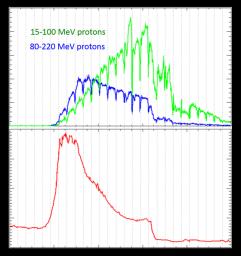Solar Storm’s Radiation at Martian Orbit and Surface
Caption:
Energetic particles from a large solar storm in September 2017 were seen both in Mars orbit and on the surface of Mars by NASA missions to the Red Planet.
The horizontal axis for both parts of this graphic is the time from Sept. 10 to Sept. 15, 2017. The upper portion of this graphic shows the increase in protons in two ranges of energy levels (15- to-100 million electron volts and 80-to-220 million electron volts), as recorded by the Solar Energetic Particle instrument on NASA's on NASA's Mars Atmosphere and Volatile Evolution orbiter, or MAVEN. The lower portion shows the radiation dose on the Martian surface, in micrograys per day, as measured by the Radiation Assessment Monitor instrument on NASA' Curiosity Mars rover. Micrograys are unit of measurement for absorbed radiation dose.
Note that only protons in the higher bracket of energy levels penetrate the atmosphere enough to be detected on the surface.
Background Info:
NASA's Goddard Space Flight Center in Greenbelt, Maryland, manages the MAVEN project for NASA's Science Mission Directorate, Washington. MAVEN's principal investigator is based at the University of Colorado Boulder's Laboratory for Atmospheric and Space Physics, where the mission's IUVS team is also based. Lockheed Martin Space Systems, Denver, built and operates the spacecraft.
For more information about MAVEN, visit
http://www.nasa.gov/maven
and
http://lasp.colorado.edu/home/maven/
.
Cataloging Keywords:
| Name |
Value |
Additional Values |
| Target |
Mars |
|
| System |
|
|
| Target Type |
Planet |
|
| Mission |
Mars Atmosphere and Volatile Evolution (MAVEN) |
Mars Science Laboratory (MSL) |
| Instrument Host |
MAVEN |
Curiosity Rover |
| Host Type |
Orbiter |
Rover |
| Instrument |
|
|
| Detector |
|
|
| Extra Keywords |
Atmosphere, Color, Storm |
| Acquisition Date |
|
| Release Date |
2017-09-29 |
| Date in Caption |
|
|
| Image Credit |
NASA/GSFC/JPL-Caltech/Univ. of Colorado/SwRI-Boulder/UC Berkeley |
| Source |
photojournal.jpl.nasa.gov/catalog/PIA21856 |
| Identifier |
PIA21856 |

 Planetary Data System
Planetary Data System
